Related Research Articles
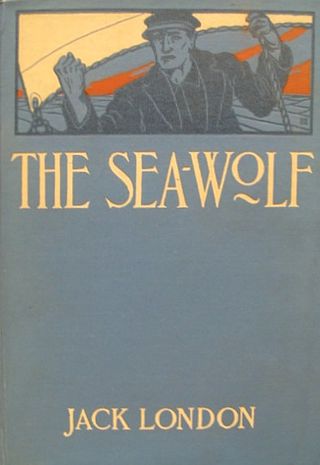
The Sea-Wolf is a 1904 psychological adventure novel by American writer Jack London. The book's protagonist, Humphrey Van Weyden, is a literary critic who is a survivor of an ocean collision and who comes under the dominance of Wolf Larsen, the powerful and amoral sea captain who rescues him. Its first printing of forty thousand copies was immediately sold out before publication on the strength of London's previous The Call of the Wild. Ambrose Bierce wrote, "The great thing—and it is among the greatest of things—is that tremendous creation, Wolf Larsen... the hewing out and setting up of such a figure is enough for a man to do in one lifetime... The love element, with its absurd suppressions, and impossible proprieties, is awful."

RMS Empress of Ireland was a British-built ocean liner that sank near the mouth of the Saint Lawrence River in Canada following a collision in thick fog with the Norwegian collier Storstad in the early hours of 29 May 1914. Although the ship was equipped with watertight compartments and, in the aftermath of the Titanic disaster two years earlier, carried more than enough lifeboats for all aboard, she foundered in only 14 minutes. Of the 1,477 people on board, 1,012 died, making it the worst peacetime maritime disaster in Canadian history.
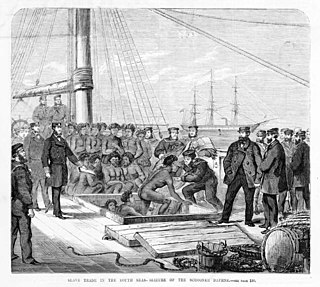
Blackbirding is the coercion of people through deception or kidnapping to work as slaves or poorly paid labourers in countries distant from their native land. The practice took place on a large scale with the taking of people indigenous to the numerous islands in the Pacific Ocean during the 19th and 20th centuries. These blackbirded people were called Kanakas or South Sea Islanders. They were taken from places such as Papua New Guinea, the Solomon Islands, Vanuatu, Niue, Easter Island, the Gilbert Islands, Tuvalu, Fiji, and the islands of the Bismarck Archipelago amongst others.
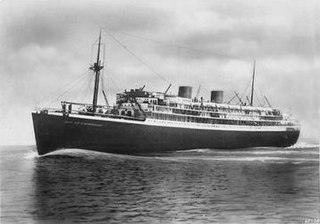
TSMS Lakonia was an ocean liner that was launched in 1929 for Netherland Line as the ocean liner Johan van Oldenbarnevelt. In 1962 she became the Greek Line cruise ship TSMS Lakonia. On 22 December 1963 she caught fire at sea and on 29 December she sank. 128 people were killed in the disaster.

Marco Polo was a three-masted wooden clipper ship, launched in 1851 at Saint John, New Brunswick. She was named after Venetian traveler Marco Polo. The ship carried emigrants and passengers to Australia and was the first vessel to make the round trip from Liverpool in under six months. Later in her career, the ship was used as a cargo ship before running aground off Cavendish, Prince Edward Island, in 1883.

William Henry "Bully" Hayes was a notorious American ship's captain who engaged in blackbirding in the 1860s and 1870s.
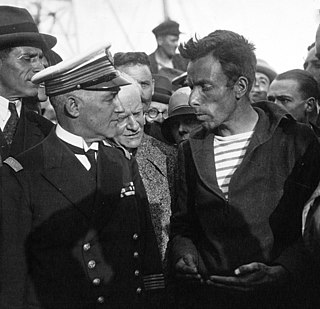
Alain Jacques Georges Marie Gerbault was a French sailor, writer and tennis champion, who made a circumnavigation of the world as a single-handed sailor. He eventually settled in the islands of south Pacific Ocean, where he wrote several books about the islanders' way of life. As a tennis player he was ranked the fifth on the French rankings in 1923.
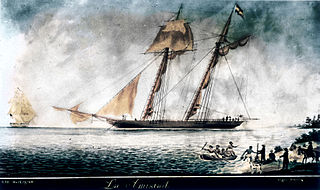
La Amistad was a 19th-century two-masted schooner owned by a Spaniard living in Cuba. It became renowned in July 1839 for a slave revolt by Mende captives who had been captured and sold to European slave traders and illegally transported by a Portuguese ship from West Africa to Cuba, in violation of European treaties against the Atlantic slave trade. Spanish plantation owners Don José Ruiz and Don Pedro Montes bought 53 captives in Havana, Cuba, including four children, and were transporting them on the ship to their plantations near Puerto Príncipe. The revolt began after the schooner's cook jokingly told the slaves that they were to be "killed, salted, and cooked." Sengbe Pieh unshackled himself and the others on the third day and started the revolt. They took control of the ship, killing the captain and the cook. Three Africans were also killed in the melee.

RMS Titanic sank on 15 April 1912 in the North Atlantic Ocean. The largest ocean liner in service at the time, Titanic was four days into her maiden voyage from Southampton to New York City, with an estimated 2,224 people on board when she struck an iceberg at 23:40 on 14 April. Her sinking two hours and forty minutes later at 02:20 ship's time on 15 April, resulted in the deaths of more than 1,500 people, making it one of the deadliest peacetime maritime disasters in history.

The Cruise of the Snark (1911) is a non-fictional, illustrated book by Jack London chronicling his sailing adventure in 1907 across the south Pacific in his ketch the Snark. Accompanying London on this voyage was his wife Charmian London and a small crew. London taught himself celestial navigation and the basics of sailing and of boats during the course of this adventure and describes these details to the reader. He visits exotic locations including the Solomon Islands and Hawaii, and his first-person accounts and photographs provide insight into these remote places at the beginning of the 20th century.

Laulasi island is an artificial island in the Langa Langa Lagoon, South of Auki on the island of Malaita in Solomon Islands. It is believed that hostilities among the inlanders of Malaita forced some people into the lagoon where over time they built their islands on sandbars after diving for coral. The religion of the island was based on prayers and offerings to the ghosts of dead ancestors, mediated by priests who kept their skulls and relics in tabu houses. Some ancestors were incarnated as sharks which protected their descendants. Langalanga is also the main source of the shell money now made in Solomon Islands.

Langa Langa Lagoon or Akwalaafu is a natural lagoon on the West coast of Malaita near the provincial capital Auki within Solomon Islands. The lagoon is 21 km in length and just under 1 km wide. The "lagoon people" or "salt water people" live on small artificial islands built up on sand bars over time where they were forced to flee from the headhunters of mainland Malaita.
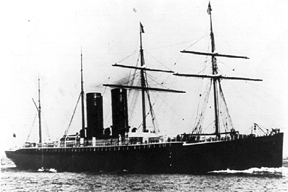
SS Oregon was a record-breaking British passenger liner that won the Blue Riband for the Guion Line as the fastest liner on the Atlantic in 1884. She was sold to the Cunard Line after a few voyages and continued to improve her passage times for her new owner. In 1885, Oregon was chartered to the Royal Navy as an auxiliary cruiser, and her success in this role resulted in the Admiralty subsidizing suitable ships for quick conversion in the event of a crisis. She returned to Cunard service in November 1885 and four months later collided with a schooner while approaching New York. Virtually all persons on board were rescued before Oregon sank. Her wreck, 18 miles south of Long Island, remains a popular diving site.

William Ion Belton Crealock was a yacht designer and author. He was one of the world's leading yacht designers from the 1960s through the 1990s, and his yachts were owned by the famous and wealthy, including Walter Cronkite and William Hurt.
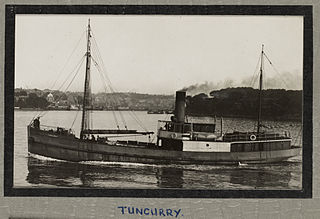
The Tuncurry was a wooden carvel screw steamer built in 1903 at Cape Hawke in the Australian state of New South Wales, that was wrecked when she sprang a leak whilst carrying explosives, cement, whiskey, jam and other general cargo between Sydney and Brisbane. She was lost off Barrenjoey Head, Broken Bay, New South Wales on 22 October 1916.
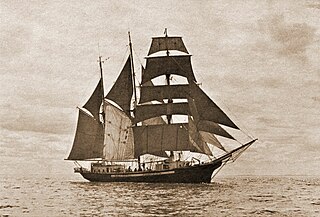
The sailing ship Regina Maris was originally built as the three-masted topsail schooner Regina in 1908. She was a 144-foot (44-meter), wooden, completely fore-and-aft–rigged sailing ship with three masts. She was re-rigged in 1963 as a 148-foot (45-meter) barquentine. Regina Maris could reach a speed of up to 12 knots, especially on a half-wind course or with a fresh back-stay breeze.

SS Arctic, an American paddle steamer owned by the Collins Line, sank on September 27, 1854, 50 miles (80 km) off the coast of Newfoundland after a collision with SS Vesta, a much smaller French vessel. Passenger and crew lists indicate that there were probably more than 400 on board; of these, only 88 survived, most of whom were members of the crew. All the women and children on board perished.
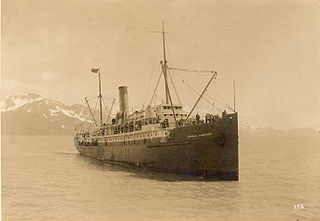
The SS Admiral Sampson was a U.S.-flagged cargo and passenger steamship that served three owners between 1898 and 1914, when it was rammed by a Canadian passenger liner and sank in Puget Sound. Following its sinking off Point No Point, the Admiral Sampson has become a notable scuba diving destination for advanced recreational divers certified to use rebreathing equipment.
J.W. Clise was a four master schooner built in 1904 in United States and sailed for both Norwegian and American companies.

The C&C Custom 67 is a Canadian sailboat, that was designed by Robert W. Ball of C&C Yachts and was launched and named Archangel in September 1980. She remains the largest pleasureboat commission ever received by C&C, and epitomized a trend within C&C during the later 1970s and early 1980s toward more cruising-oriented designs under George Cuthbertson's direction, a trend best illustrated by the development of the Landfall series.
References
- ↑ The Heathen title listing at the Internet Speculative Fiction Database, accessed 15 November 2015.
- ↑ The Strength of the Strong The World of Jack London, accessed 15 November 2015.
- ↑ pp129–130 Jack London, Gary Riedl and Thomas R. Tietze, Jack London's Tales of Cannibals and Headhunters, UNM Press, 2006, accessed 24 November 2015.